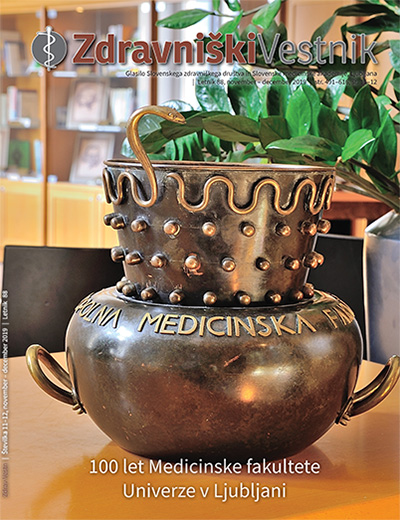Percutaneous closure of patent foramen ovale and atrial septal defect
A case report
DOI:
https://doi.org/10.6016/ZdravVestn.2872Keywords:
atrial septal defect, patent foramen ovale, percutaneous closureAbstract
A 67-year old man with a hemodynamically significant type secundum atrial septal defect (ASD), large patent foramen ovale (PFO) and significant septal aneurism presented with shortness of breath and limited exercise tolerance. There was no evidence of additional structural abnormalities nor significant coronary artery disease. Simultaneous percutaneous closure of both defects was planned. Since the wire could have been passed only through PFO and the second wire not through the ASD, only PFO was closed with 35 mm Amplatz PFO occluder. After 3 months, which served for tissue ingrowth of Amplatz PFO occluder and aneurism stabilization, ASD located in posterior-inferior part of fossa ovalis documented by three-dimensional transesophageal echocardiography (3D-TEE) was easily crossed and successfully closed with a 12 mm Amplatz ASD occluder. Stable position without unwanted interference between the devices was obtained. There was noresidual shunting on color Doppler and no bubble shunting during Valsalva maneuver. Within 6 months after the procedure, symptoms significantly improved and right heart chambers decreased. 3D-TEE revealed both devices in good position with only trivial shunting through PFO occluder documented by color Doppler.
Downloads
References
1. Dolenc J, Koželj M, Prokšelj K. Najpogostejše zmote pri obravnavi odraslih bolnikov s prirojenimi srčnimi napakami. Zdrav Vestn. 2012;81:312-9.
2. Berger F, Ewert P. Atrial septal defect: waiting for symptoms remains an unsolved medical anachronism. Eur Heart J. 2011;32(5):531-4.
DOI: 10.1093/eurheartj/ehq377
PMID: 20971748
3. Humenberger M, Rosenhek R, Gabriel H, Rader F, Heger M, Klaar U, et al. Benefit of atrial septal defect closure in adults: impact of age. Eur Heart J. 2011;32(5):553-60.
DOI: 10.1093/eurheartj/ehq352
PMID: 20943671
4. Dolenc J, Cerar A, Cvijić M, Prokšelj K, Mirta K. Long-term follow up after transcatheter closure of atrial septal defect and patent foramen ovale in adults. Zdrav Vestn. 2013;82:809-17.
5. Carroll JD, Saver JL, Thaler DE, Smalling RW, Berry S, MacDonald LA, et al.; RESPECT Investigators. Closure of patent foramen ovale versus medical therapy after cryptogenic stroke. N Engl J Med. 2013;368(12):1092-100.
DOI: 10.1056/NEJMoa1301440
PMID: 23514286
6. Meier B, Kalesan B, Mattle HP, Khattab AA, Hildick-Smith D, Dudek D, et al.; PC Trial Investigators. Percutaneous closure of patent foramen ovale in cryptogenic embolism. N Engl J Med. 2013;368(12):1083-91.
DOI: 10.1056/NEJMoa1211716
PMID: 23514285
7. Furlan AJ, Reisman M, Massaro J, Mauri L, Adams H, Albers GW, et al.; CLOSURE I Investigators. Closure or medical therapy for cryptogenic stroke with patent foramen ovale. N Engl J Med. 2012;366(11):991-9.
DOI: 10.1056/NEJMoa1009639
PMID: 22417252
8. Webb G, Gatzoulis MA. Atrial septal defects in the adult: recent progress and overview. Circulation. 2006;114(15):1645-53.
DOI: 10.1161/CIRCULATIONAHA.105.592055
PMID: 17030704
9. Černič Šuligoj N, Zorc M, Grad A, Kar S, Noč M. Perkutano zapiranje ovalnega okna-izkušnje z novejšimi tipi zapiral. Slov Kardiol. 2011;8:13-7.
10. Černič Šuligoj N, Zorc M, Kar S, Noč M. Perkutano zapiranje defekta preddvornega pretina tipa sekundum pri odraslih bolnikih - naše izkušnje. Slov Kardiol. 2012;9:4-9.
11. Noc M, Cernic Suligoj N, Zvan B, Zorc M, Kar S. In-tunnel closure of patent foramen ovale with a FlatStent EF™. Kardiol Pol. 2015;73(7):549-56.
DOI: 10.5603/KP.a2015.0026
PMID: 25733171
Published
Issue
Section
License

The Author transfers to the Publisher (Slovenian Medical Association) all economic copyrights following form Article 22 of the Slovene Copyright and Related Rights Act (ZASP), including the right of reproduction, the right of distribution, the rental right, the right of public performance, the right of public transmission, the right of public communication by means of phonograms and videograms, the right of public presentation, the right of broadcasting, the right of rebroadcasting, the right of secondary broadcasting, the right of communication to the public, the right of transformation, the right of audiovisual adaptation and all other rights of the author according to ZASP.
The aforementioned rights are transferred non-exclusively, for an unlimited number of editions, for the term of the statutory
The Author can make use of his work himself or transfer subjective rights to others only after 3 months from date of first publishing in the journal Zdravniški vestnik/Slovenian Medical Journal.
The Publisher (Slovenian Medical Association) has the right to transfer the rights of acquired parties without explicit consent of the Author.
The Author consents that the Article be published under the Creative Commons BY-NC 4.0 (attribution-non-commercial) or comparable licence.



